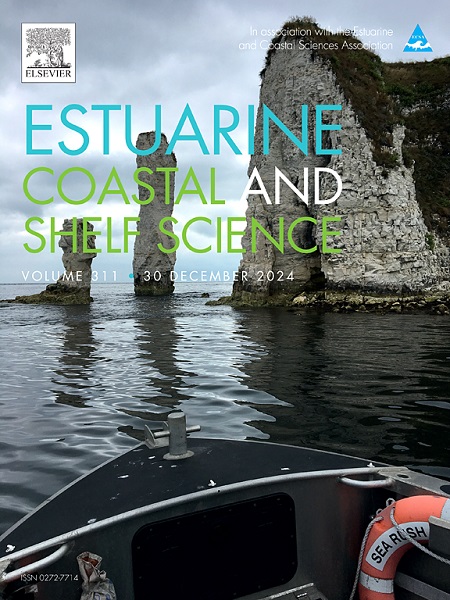IF 2.6
3区 地球科学
Q1 MARINE & FRESHWATER BIOLOGY
引用次数: 0
摘要
礁岛有高度动态的海滩,海岸线很容易因受风况、台风和海平面影响的波浪模式变化而改变。岛礁系统内部和周围的生境条件也会影响海岸线的完整性。绘制海岸线运动模式对于了解其演变以及对气候和人为变化的潜在反应至关重要。这些数据由2022年获得的现场岸线位置补充。统计数据是使用数字海岸线分析系统(DSAS)计算的。在礁岛之间,海岸线变化的模式和速度各不相同。帕罗拉岛发生了净增积,而其他岛屿则发生了净侵蚀。岛屿东部的侵蚀率普遍较高,而西南部的侵蚀率最高。位于环礁以东的岛屿显示出更大的侵蚀。总体的海岸线格局归因于研究期间西南季风强度的减弱和东北季风强度的相对恒定。因此,东北风驱动的西南沙流占主导地位,而西南风驱动的东北沙流占主导地位。海岸线也会对突发的自然和人为压力做出反应。高波能条件、2014年台风黑格比和2017年台风频繁,给海岛地区造成了重大损失。植被指数绿色(viggreen)也被计算来评估植被覆盖的程度。植被覆盖的损失也与岛屿地区的损失有关。2013年至2014年期间,在礁滩上进行了大规模的疏浚,导致沉积物流入海岸的高度升高,这可能暂时缓解了侵蚀。疏浚使沉积物暴露并释放到礁石上。然而,这项活动减少了活珊瑚的覆盖面积,并有效地增加了礁滩的水深。因此,这将降低珊瑚礁长期维持向岛屿供应沉积物的能力。鉴于海平面上升对小型礁岛系统的影响,这些不同的自然和人为影响对于管理有限的沉积物资源至关重要。本文章由计算机程序翻译,如有差异,请以英文原文为准。

Shoreline movements around small reef islands of the Kalayaan Island Group, West Philippine Sea
Reef islands have highly dynamic beaches, with shorelines that shift easily due to changes in wave patterns influenced by wind conditions, typhoons, and sea-level. Habitat conditions within and around reef island systems also impact shoreline integrity. Mapping shoreline movement patterns is essential for understanding their evolution and potential responses to climate and human-induced changes.
Shoreline positions for several islands in the Kalayaan Islands, West Philippine Sea—including Pag-asa, Parola, Kota, Likas, and Lawak—were traced from satellite images obtained via Google Earth, covering the period from 2005 to 2023. These are complemented by field-derived shoreline positions acquired during 2022. Statistics were calculated using the Digital Shoreline Analysis System (DSAS). Patterns and rates of shoreline change vary among the reef islands. Net accretion has taken place in Parola Island while the rest of the islands have net erosion. Erosion rates are generally high on the eastern sections of the islands, while the southwest sections experience the highest accretion rates. Islands positioned more east of their atolls show greater erosion. The overall shoreline patterns are attributed to the reduced southwest (SW) monsoon and relatively constant northeast (NE) monsoon intensities during the period covered by this study. Consequently, the southwest sediment drift driven by the NE winds dominated over the northeastward sediment drift driven by the SW winds.
Shorelines also respond to sudden natural and anthropogenic stressors. Episodes of high wave energy conditions, Typhoon Hagupit in 2014 and frequent typhoons in 2017, caused substantial losses in island area. Vegetation Index Green (VIgreen) was also computed to assess the extent of vegetation coverage. Losses in vegetation cover also correlate with losses in the island area. A disturbance that likely tempered erosion, temporarily, is the elevation of sediment input to the coast caused by extensive dredging on the reef flat between 2013 and 2014. Dredging exposed and released sediment to the reef. However, this activity reduced the living coral cover and effectively increased the water depth on the reef flat. Consequently, this will decrease the reef's ability to sustain sediment supply to the island in the long term. These various natural and anthropogenic impacts are vital in managing limited sediment resources in light of rising sea levels on small reef island systems.
求助全文
通过发布文献求助,成功后即可免费获取论文全文。
去求助
来源期刊
CiteScore
5.60
自引率
7.10%
发文量
374
审稿时长
9 months
期刊介绍:
Estuarine, Coastal and Shelf Science is an international multidisciplinary journal devoted to the analysis of saline water phenomena ranging from the outer edge of the continental shelf to the upper limits of the tidal zone. The journal provides a unique forum, unifying the multidisciplinary approaches to the study of the oceanography of estuaries, coastal zones, and continental shelf seas. It features original research papers, review papers and short communications treating such disciplines as zoology, botany, geology, sedimentology, physical oceanography.

 求助内容:
求助内容: 应助结果提醒方式:
应助结果提醒方式:


